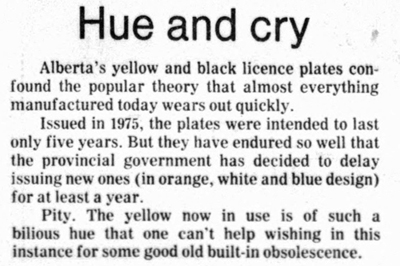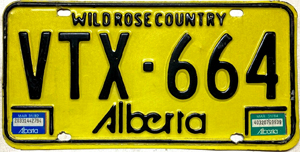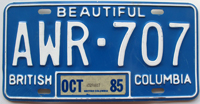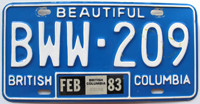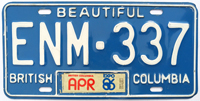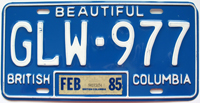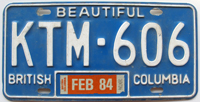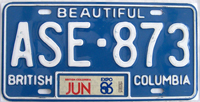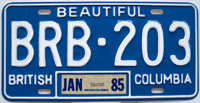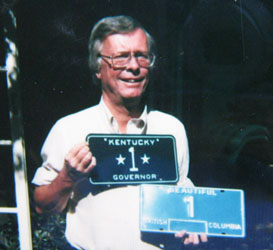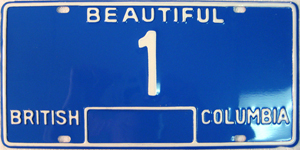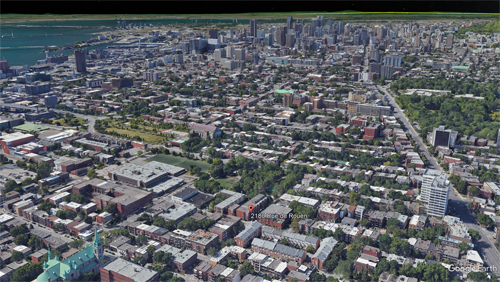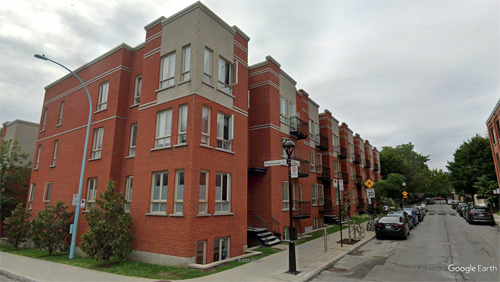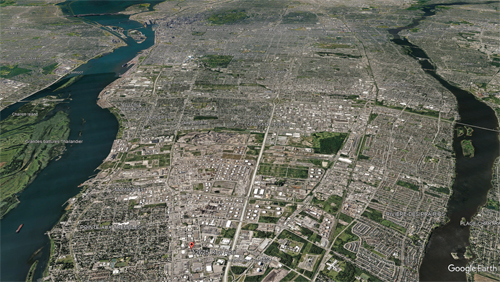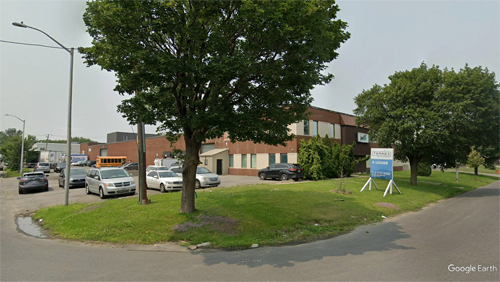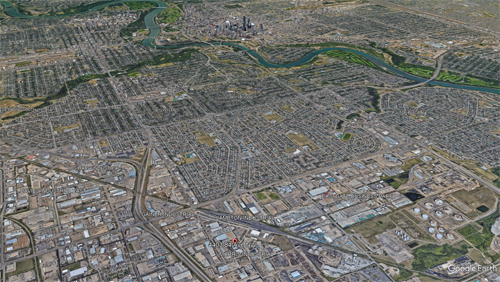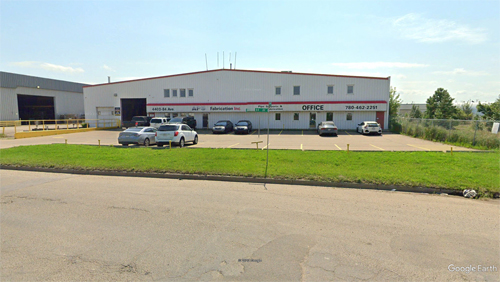|
|||||||||||||||||||||||||||||||||||||||||||||||||||||||||||||||||||||||||||||||||||||||||||||||||||||||||||||||||||||||||||||||||||||||||||||||||||||||||||||||||||||||||||||||||||||||||||||||||||||||||||||||||||||||||||||||||||||||||||||||||||||||||||||||||||||||||||||||||||||||||||||||||||||||||||
Quick Links: |
*
* * * * |
| 1979-85 | |||||||||||||||||||||||||
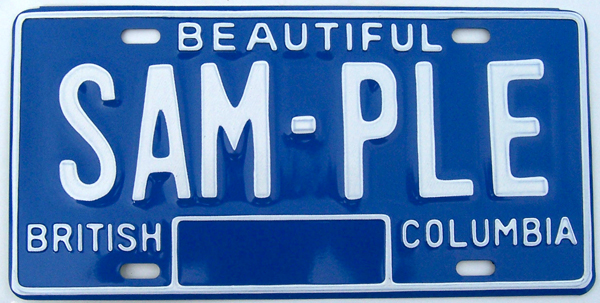 |
|
||||||||||||||||||||||||
Reg Whitlock, the Superintendent of the Motor Vehicle Branch (MVB) further advised that the plates “would make provision for larger decals which would clearly show the month of issue when the Insurance Corp. of B.C. gets around to cyclical decals” and that ICBC was still studying how to go about the switch-over (can anyone else sense a little bit of tension between the MVB and ICBC?). ICBC fully intended to “get around” to cyclical decals and actually had a five (5) year plan aimed at alleviating the annual February rush of motorists purchasing their license plates/decals. It was estimated there would be a 20% annual turn-over of people moving from the February 28th deadline to a different date in the calendar. By 1984, it was hoped that renewals would be spread out evenly over the year. For the first couple of years, however, February would remain a busy month.
The new plates would also start at AAA-001, similar to where the 1970 base serial had started, and would progress through to KKL-999 before turning over to the second block of one million plates starting at AAL-001, followed by a third block of one million plates starting at ALL-001. At its October 1978 Convention, Social Credit Party delegates passed a resolution calling for the retention of the “Beautiful” slogan on BC license plates and, surprise-surprise, the slogan remained at the top of the new plates! |
While no formal announcement regarding this Tender was ever released, it is known that ACME Signalisation Inc. was awarded the contract and that the province was sufficiently happy enough with ACME's work to exercise the option for 1979. This can be seen in the continuation of ACME's dies that had been used on the plates issued in 1978 on the new 1979 license base. For reference purposes, the following galleries show a comparison of these ACME dies as they appeared on the 1977 Quebec license plates and the 1979 BC license plates. NOTE: Quebec switched to a “AAA-000” format serial in 1983, so it is not possible to compare letter between the two provinces in the late 1970s: |
1977 Quebec Die Types (0-9) |
|||||||||
 |
 |
 |
 |
 |
 |
 |
 |
 |
 |
1979 British Columbia Die Types (0-9) |
|||||||||
 |
 |
 |
 |
 |
 |
 |
 |
 |
 |
The first block of one million license plates, which began to be issued in 1979, display the sharp, crisp dies that characterized ACME's plates produced for the province in 1978. The series commenced at AAA-001 and progressed through to KKJ-999 and were generally issued throughout 1979 and were completely issued before the end of the year as their were 1,125,654 registered passenger vehicles in the province at this time. |
| Gallery - 1st Block of 1,000,000 plates (1979) | ||||
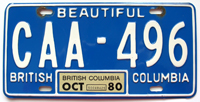 |
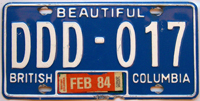 |
|||
 |
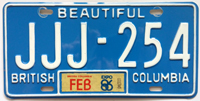 |
|||
Following the issuance of license plate No. KKJ-999, likely in late-1979, the second block of one million plates began to be issued starting at AAL-001 and progressing through to KKX-999. For reasons that are lost time, the quality of the plates that ACME produced declined markedly in this block with the stamping of the letters and numbers becoming less crisp and the application of the paint appearing shoddy, hence the characterization of ACME plates by collectors as “sloppy” and or a poorer quality than some other manufacturers. Oddly, there is a small exception to this for plates produced between approximately “EAX-xxx” and “FKS-xxx” (and possibly into the “GDN-xxx”) where the crisp, clean appearance characteristic of the initial block re-appears (see the gallery further below): |
"Clean" ACME Plates |
|||||||||
 |
 |
 |
 |
 |
 |
 |
 |
 |
 |
"Sloppy" ACME Plates |
|||||||||
 |
 |
 |
 |
 |
 |
 |
 |
 |
 |
| Gallery - 2nd Block of 1,000,000 plates (1979-82) | ||||
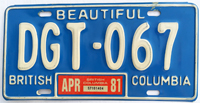 |
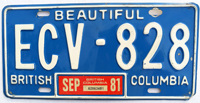 |
|||
 |
||||
As there were 1,630,357 vehicles registered in 1980, this represented about 15.9% of all license plates being turned-over each year, which is slightly below what the MVB had estimated would occur (i.e. 20%). |
In an creepy twist, Stratten's breakthrough was the result of Snider convincing her to pose for some nudies in 1978 (despite being under aged), which he then submitted to Playboy. A whirlwind events followed for Stratten, including relocation to Los Angeles, marriage to Snider, selection as “Miss August” of 1979, a job at the L.A. Playboy Club, a number of minor TV and film rolls followed by being named “Playmate of the Year” for 1980. To commemorate this highest of Hefner-ian honours, Snider ordered personalized California license plates for his car with the slogan “STAR 80”:
A decision to separate from Snider, who was financially dependent on Stratten and possessed a volatile personality, ultimately ended in tragedy when Snider committed a murder-suicide in August of 1980.
The movie came out in 1983 and was adapted from the Pulitzer Prize-winning Village Voice article “Death of a Playmate” by Teresa Carpenter. Other movies and books have been written about Stratten for those interested in her story while an interesting bit of music trivia holds that The “Best Was Yet To Come”, which is the closing track on Vancouver musician Bryan Adams 1983 album, Cuts Like a Knife, was written about Stratten. |
|
On November 14, 1980, the Insurance Corporation of British Columbia (ICBC) announced that it would be increasing the rates on some insurance plans by as much as 70% effective on midnight that same day. When word got out to the media, motorists began flocking to local Autoplan Agents to cancel their current insurance/registration and then instantly apply for a new 12-month insurance plan at the lower rates still in effect. The rush was so heavy, that some Agents ran out of November 1981 decals. For many motorists the typical increase was around 38% so someone with coverage that cost $500 in 1980 would be paying $652 for the same coverage in 1981. |
While some jurisdictions have actually introduced such plates, including Minnesota and Ohio, a lot of others just talk about it, including British Columbia in May of 1981.
More specifically, Skelly “asked the minister to consider introducing a system used in Australia where the accident-free driver carries a capital 'M' on his licence plate to signify that he's a master driver while the probationary driver carries a 'P' so 'everybody knows who the guy is'. In between the two categories the impaired driver is forced to carry a special sign 'so that everybody on the street knows they should avoid this guy like the plague because he doesn't have a very good driving record'.” Carrying the brand of Cain was, Skelly thought, enough of an embarrassment that drivers would do everything possible to have it removed, including being better drivers. The Victoria Times-Colonist thought this an excellent idea as “throughout the history of mankind, the custom of publicly shaming law-breakers and sinners has served as a powerful deterrent, an inducement to tread the straight and narrow” and used the City's example of naming tax cheats as a model. The paper even went so far as to suggest a “big, black M (for menace)” might work best. As quickly as it arrived, the debate on branding bad drivers disappeared and while it may have seemed a fatuous release of hot-air by politicians and editorial writers, in 1982 the government began to float the idea of introducing a graduated licensing system in which new drivers would have to display an “L” next to their license plate for 6-months to let everyone know they were a “Learner”. It would not be until 1998 that such a graduated licensing program would become a reality, and while the presence of “L” (“Learner”) and “N” (“New”) decals beside license plates are now ubiquitous, there has yet to be an “M” (“Menace”) decal:
Shown at left is the version of the plate Doughtery prepared for consideration by officials in Tennessee, home to Nashville; “the nation's safest city”. The plates would have been required for anyone who violated traffic laws. |
Following the issuance of license plate No. KKX-999, likely in late-1981 or early 1982, the third block of one million plates began to be issued starting at ALL-001 and progressing through to KXX-999. The poor quality ACME plates continued into this 3rd block with the sloppy stamping and paint characteristic of the 2nd block readily apparent. We suspect that it is for this reason that the province choose to either cancel or not renew its contract with ACME, resulting the end of the so-called “Quebec dies” around license plate No. ARX-999 (or thereabouts). Based on a quick back-of-the-napkin calculation, this resulted in about 50,000 license plate sets in the 3rd block sporting ACME dies. |
| Gallery - 3rd Block of 1,000,000 plates - ACME dies (1982) | ||||
 |
||||

Picking up where ACME left off was Hi-Signs Manufacturing Limited, a company based in Edmonton, Alberta at the time, but with roots in BC.
From this initial foray, Foster is reported to have relocated Hi-Signs to Regina in the early 1970s when he purportedly won the contract to produce license plates for Saskatchewan. While we have been able to confirm (through media reports & Hansard) that Hi-Signs was located in Regina prior to expanding to Edmonton in 1974 (or 1975) and was making plates for the Wheat Province (and possibly Manitoba), we are also aware of contradictory information suggesting that Saskatchewan license plates were made by Western Tool and Industries of Winnipeg from 1965 to 1976. In winning the contract to produce Alberta's license plates for 1975, Hi-Signs was taking over from prison labour at the provincial jail in Fort Saskatchewan and purchased the equipment from this shop for use at its new Edmonton facility.
While Hi-Signs was creating the economy-of-scale that Alberta lacked by now producing license plates for all three (3) Prairie Provinces, its production of the 1975 Alberta plates was beset by one calamity after another.
First, the market for steel was tight and shortages made it difficult for Hi-Signs to procure the supplies needed for the 1975 plates. When it was finally able to acquire the steel, it was to be delivered by rail to its Regina facility for production, but the train was involved in a wreck and the “shipment was crumpled and burned ... and had to be reordered.” Once the plates had been produced, they were shipped to Hi-Signs Edmonton facility for painting, however, according to Clarence Copithorne, Alberta Minister of Highways and Transport, Hi-Signs proceeded to “produce a poor-quality product ... and [we] have required those plates to be redone.” Copithorne lamented that “I wish we'd kept the machinery in Fort Saskatchewan”! For British Columbians, the 1975 black-on-yellow plates that Hi-Signs produced for Alberta (and which were renewed to 1984 by decals) became a source of occasional frustration due to their common association with nervous drivers slowly trying to navigate unfamiliar mountain and/or winding roads in BC, usually in the Kootenay or Okanagan valley's.
When the time the Motor Vehicle Branch (MVB) replaced ACME, Hi-Signs had long since moved beyond its initial troubles with the Alberta contract and would end up producing license plates for BC from 1982 to 1985. We know that Hi-Signs replaced ACME as the manufacturer for BC primarily due to news reports from the period indicating the plates had been manufactured in Edmonton (a dead giveaway!):
But, of course, there are always the dies, and those that began to appear on BC plates in 1982 are commonly referred to in the hobby as “Nova Scotia Dies” (despite being manufactured in Edmonton). This is because these are the same dies that Hi-Signs used to manufacture plates for Nova Scotia starting in 1980. For comparison purposes, galleries of the dies used by ACME on the 1979 British Columbia plates ("Clean" version) and those used by Hi-Signs on the 1980 Nova Scotia license plates and on BC plates between 1982-85 are shown below: |
1979 British Columbia (ACME) Die Types (0-9) |
|||||||||
 |
 |
 |
 |
 |
 |
 |
 |
 |
 |
1980 Nova Scotia (Hi-Signs) Die Types (0-9) |
|||||||||
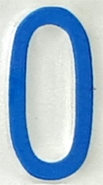 |
 |
 |
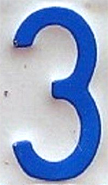 |
 |
 |
 |
 |
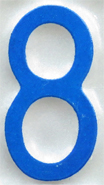 |
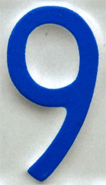 |
1982 British Columbia (Hi-Signs) Die Types (0-9) |
|||||||||
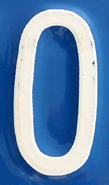 |
 |
 |
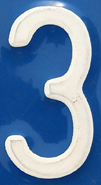 |
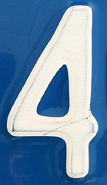 |
 |
 |
 |
 |
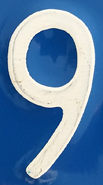 |
| Gallery - 3rd Block of 1,000,000 plates - Hi-Signs dies (1982-85) | ||||
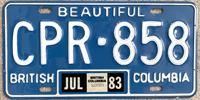 |
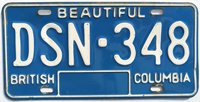 |
|||
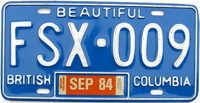 |
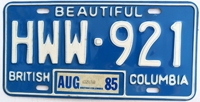 |
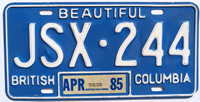 |
||
Due to production delays, the roll-out of newly re-designed license plates in 1985 had to be deferred, meaning the 1979 base-plate had to be extended by a number of months. This meant an addition 150,000 plates would be required, and these would be part of the 4th block of one million plates, even the whole block would never be needed. These plates started at ALA-000 and running through to BRB-999 by the summer of 1985. |
| Gallery - 4th Block of 1,000,000 plates (1985) | |||||||||
|
|||||||||
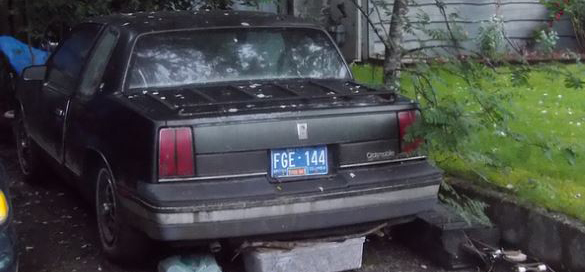 As seen in 2013. Not clear if this is the car the plates were issued to, but if it is it is sure holding up well for being off the road for almost 30 years. As seen in 2013. Not clear if this is the car the plates were issued to, but if it is it is sure holding up well for being off the road for almost 30 years. |
This
oddball showed up for sale in late 2009 as part of the
liquidation of Wes Willoughby's collection: |
|||
|
|||
Based out of San Francisco, Willoughby spent approximately 20 years amassing the first collection of license plates from every issuing state, nation, province, island and territory in the world! When this particular plate was listed for sale (at $250 USD for those who are curious), it was claimed that it had previously been on the Premier's own vehicle. While it is a common practice in the United States for the Governor to be issued with plate No. 1, this is not the case in British Columbia, nor does the single-digit correspond with the alpha-numeric series used by the province since 1970. Rather, it is assumed that in his quest for a plate from every jurisdiction, Willoughby wrote to the Province requesting a specimen and was presented with what can best be described as a test plate happening to bare the coveted No. 1. |
| ACME Signalisation: Postscript |
It was reported that “less than a year after buying ACME Signalisation (in 1971), André Brouillette acquired three other competing factories that manufactured siding panels and brought the entire industry under one roof.” A 1975 profile of the company indicated that this address was 2180 Rouen Road in Montreal, but other known addresses included 2031 des Carrieres Street, Montreal (Head Office in 1971), 12625 April Road (Rue April), Point-aux-Trembles and 12425 Boulevard Industriel, Point-aux-Trembles (in the 1980s and one block east of April Road). In 1982, ACME Signalisation was convicted under the Competition Act of having offered several thousand dollars to a competitor in the sign-making business to tender a specific bid (R. v. Andre Brouillette and Acme Signalisation). The penalty imposed was a then record $150,000; with half of this ($75,000) being assessed against the company (ACME) and the other half being assessed against Andre Brouillette in his role as President of ACME. While ACME will make one more cameo (see the next page on 1985-2001) it is known that they did continue to produce license plates for Quebec, New Brunswick, Newfoundland and even Jamaica(!) in this time period, but did not directly make any more plates for BC after 1981. By the early 1990s ACME appears to have become moribund and officially declared bankruptcy in 1994. Out of curiosity, we here at BCpl8s.ca took a look on Google Earth to see what had become of the location of ACME's former shop at 2180 Rouen Road. As can be seen, the site has been redeveloped to a residential use. It is not clear to us if this was a complete re-development (i.e. demolition and re-build) or a conversion of the previous building that ACME used on the site. |
2180 Rue Rouen, Montreal |
|
12625 Rue April, Point-aux-Trembles |
|
| Hi-Signs: Postscript |
Out of curiosity, we here at BCpl8s.ca took a look on Google Earth to see what had become of the location of Hi-Signs former shop at 4403 84th Avenue Northwest in Edmonton. While it is still there, the use has changed and, while Hi-Signs is still operating, they are no longer in the license plate manufacturing business (probably exiting in the early 2000s) and are focused on signage now: |
Quick Links: |
Antique | APEC | BC Parks | Chauffeur Badges | Collector | Commercial Truck | Consul | Dealer | Decals | Driver's Licences | Farm | Ham Radio | Industrial Vehicle | Keytags | Lieutenant Governor | Logging | Manufacturer | Medical Doctor | Memorial Cross | Motive Fuel | Motor Carrier | Motorcycle | Movie Props | Municipal | National Defence | Off-Road Vehicle | Olympics | Passenger | Personalized | Prorated | Prototype | Public Works | Reciprocity | Repairer | Restricted | Sample | Special Agreement | Temporary Permits | Trailer | Transporter | Veteran | Miscellaneous |
© Copyright Christopher John Garrish. All rights reserved.

 On September 29, 1978, the province announced that the colour of the new license plates to be issued in 1979 would by white lettering on a blue background.
On September 29, 1978, the province announced that the colour of the new license plates to be issued in 1979 would by white lettering on a blue background.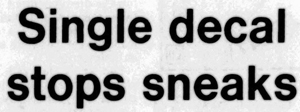 As reported in 1978, only a single registration decal would be issued to motorists for display on their rear plate. This was in order to thwart those motorists who were trying to use one set of plates on two different vehicles. Reg Whitlock of the MVB reported that
As reported in 1978, only a single registration decal would be issued to motorists for display on their rear plate. This was in order to thwart those motorists who were trying to use one set of plates on two different vehicles. Reg Whitlock of the MVB reported that 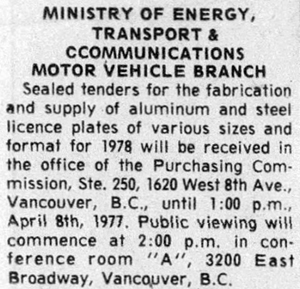 As will be recalled, the Tender to manufacture BC's 1978 license plates had contained an option for 1979.
As will be recalled, the Tender to manufacture BC's 1978 license plates had contained an option for 1979. 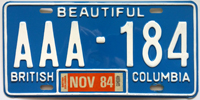


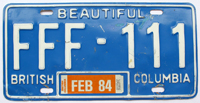
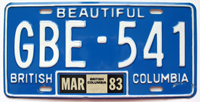

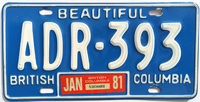

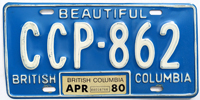
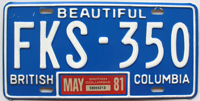

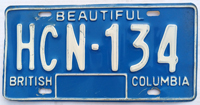
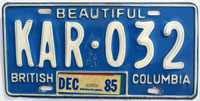
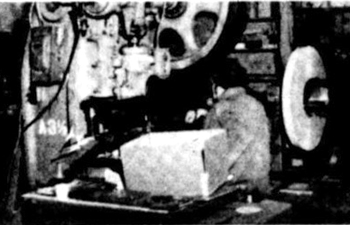

 To alleviate their boredom, one employee appears to have retreated to their
To alleviate their boredom, one employee appears to have retreated to their  ... excuse us, we here at BCpl8s.ca are going to need a few minutes to ourselves to reminisce about our past trips to Whistler ...
... excuse us, we here at BCpl8s.ca are going to need a few minutes to ourselves to reminisce about our past trips to Whistler ...
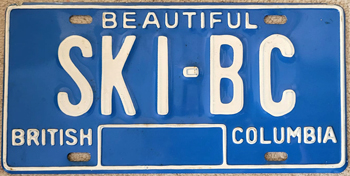
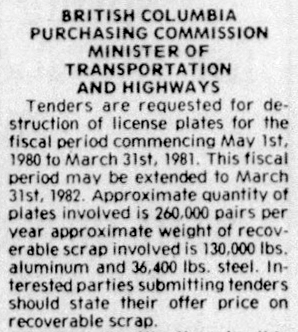 Always a good source for obscure information about license plates, the Tender released by the province in 1980 for the destruction of license plates revealed that approximately 260,000 pairs of license plates were being surrendered on a yearly basis in the early 1980s.
Always a good source for obscure information about license plates, the Tender released by the province in 1980 for the destruction of license plates revealed that approximately 260,000 pairs of license plates were being surrendered on a yearly basis in the early 1980s. In 1977, a Coquitlam teenager was on the verge of hitting the big time in Hollywood. Dorothy Stratten was working at the local Dairy Queen when she was discovered by a
In 1977, a Coquitlam teenager was on the verge of hitting the big time in Hollywood. Dorothy Stratten was working at the local Dairy Queen when she was discovered by a 


 Another idea that has been kicking around almost as long as there have been license plates is the idea of using them to brand bad drivers (i.e. drunks, speeders and other hoons).
Another idea that has been kicking around almost as long as there have been license plates is the idea of using them to brand bad drivers (i.e. drunks, speeders and other hoons). Responding to estimates for the Ministry of Highway, Bob Skelly (NDP - Alberni) suggested the failure of the provincial government to crack down on bad drivers was driving costs at ICBC upwards and something should be done.
Responding to estimates for the Ministry of Highway, Bob Skelly (NDP - Alberni) suggested the failure of the provincial government to crack down on bad drivers was driving costs at ICBC upwards and something should be done.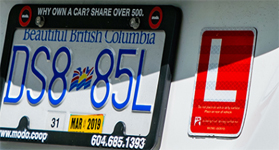

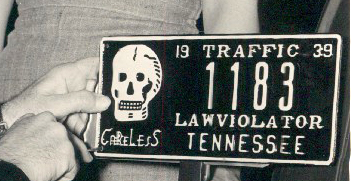 As an aside, one of the best entries in the category of shaming drivers comes from J.F. Doughtery of Beverly Hills who toured around the US in the late 1930s promoting his
As an aside, one of the best entries in the category of shaming drivers comes from J.F. Doughtery of Beverly Hills who toured around the US in the late 1930s promoting his  We here at BCpl8s.ca have been told that Hi-Signs was founded by Bob Foster in Richmond and was the company contracted to produce the first decals issued by the province to motorists in 1970.
We here at BCpl8s.ca have been told that Hi-Signs was founded by Bob Foster in Richmond and was the company contracted to produce the first decals issued by the province to motorists in 1970.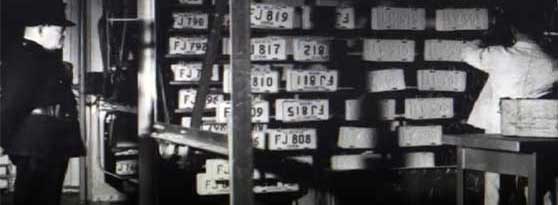
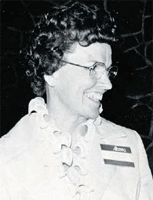 According to the (then) Alberta Solicitor General, Helen Hunley (shown at right), some of the reasons the province shut down its Fort Saskatchewan shop was because:
According to the (then) Alberta Solicitor General, Helen Hunley (shown at right), some of the reasons the province shut down its Fort Saskatchewan shop was because:
